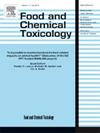尼日利亚尼日尔三角洲非洲大蜗牛体内的有机氯农药和多溴二苯醚:对膳食暴露和健康风险评估的影响。
IF 3.9
3区 医学
Q2 FOOD SCIENCE & TECHNOLOGY
引用次数: 0
摘要
对尼日利亚尼日尔三角洲不同地点的蜗牛中有机氯农药(OCP)和多溴联苯醚(PBDE)的浓度进行了评估,以提供有关其来源以及食用蜗牛可能对人类造成的风险的数据。蜗牛样本中的 OCP 和 PBDE 浓度分别为 0.31 至 12.2 纳克 g-1 和 0.21 至 10.9 纳克 g-1。从分布模式来看,OCP 和 PBDE 的主要成分分别是氯丹和五溴二苯醚。人类通过食用这些螺类而摄入的 OCPs 和 PBDEs 的危害指数和癌症总风险值分别小于 1 和 10-6(可接受风险值),表明对健康造成不良影响的可能性不大。这些蜗牛中 OCPs 的异构体比率反映了历史和近期的污染情况,而这些蜗牛中 PBDEs 的分布模式表明,污染源与该地区使用的五溴二苯醚和八溴二苯醚制剂有关,而不是十溴二苯醚混合物。本文章由计算机程序翻译,如有差异,请以英文原文为准。
Organochlorine pesticides and polybrominated diphenyl ethers in giant African snail from the Niger Delta, Nigeria: Implications for dietary exposure and health risk assessment
The concentrations of organochlorine pesticides (OCPs) and polybrominated diphenyl ethers (PBDEs) were evaluated in snails from different locations in the Niger Delta of Nigeria to provide data about their sources and possible risk to humans from the consumption of snails. The OCP and PBDE concentrations in snail samples ranged from 0.31 to 12.2 ng g−1 and 0.71 to 10.9 ng g−1, respectively. The distribution patterns indicated the dominance of chlordanes and penta-BDEs for OCPs and PBDEs, respectively. The hazard index and total cancer risk values for human exposure to OCPs and PBDEs through consumption of these snails were less than 1 and 10−6 (acceptable risk values), respectively, indicating unlikely adverse health effects. The isomer ratios of OCPs in these snails reflected both historical and recent contamination, while the distribution patterns of PBDEs in these snails indicated sources linked to the use of the penta-BDE and octa-BDE formulations rather than the deca-BDE mixture in this region.
求助全文
通过发布文献求助,成功后即可免费获取论文全文。
去求助
来源期刊

Food and Chemical Toxicology
工程技术-毒理学
CiteScore
10.90
自引率
4.70%
发文量
651
审稿时长
31 days
期刊介绍:
Food and Chemical Toxicology (FCT), an internationally renowned journal, that publishes original research articles and reviews on toxic effects, in animals and humans, of natural or synthetic chemicals occurring in the human environment with particular emphasis on food, drugs, and chemicals, including agricultural and industrial safety, and consumer product safety. Areas such as safety evaluation of novel foods and ingredients, biotechnologically-derived products, and nanomaterials are included in the scope of the journal. FCT also encourages submission of papers on inter-relationships between nutrition and toxicology and on in vitro techniques, particularly those fostering the 3 Rs.
The principal aim of the journal is to publish high impact, scholarly work and to serve as a multidisciplinary forum for research in toxicology. Papers submitted will be judged on the basis of scientific originality and contribution to the field, quality and subject matter. Studies should address at least one of the following:
-Adverse physiological/biochemical, or pathological changes induced by specific defined substances
-New techniques for assessing potential toxicity, including molecular biology
-Mechanisms underlying toxic phenomena
-Toxicological examinations of specific chemicals or consumer products, both those showing adverse effects and those demonstrating safety, that meet current standards of scientific acceptability.
Authors must clearly and briefly identify what novel toxic effect (s) or toxic mechanism (s) of the chemical are being reported and what their significance is in the abstract. Furthermore, sufficient doses should be included in order to provide information on NOAEL/LOAEL values.
 求助内容:
求助内容: 应助结果提醒方式:
应助结果提醒方式:


